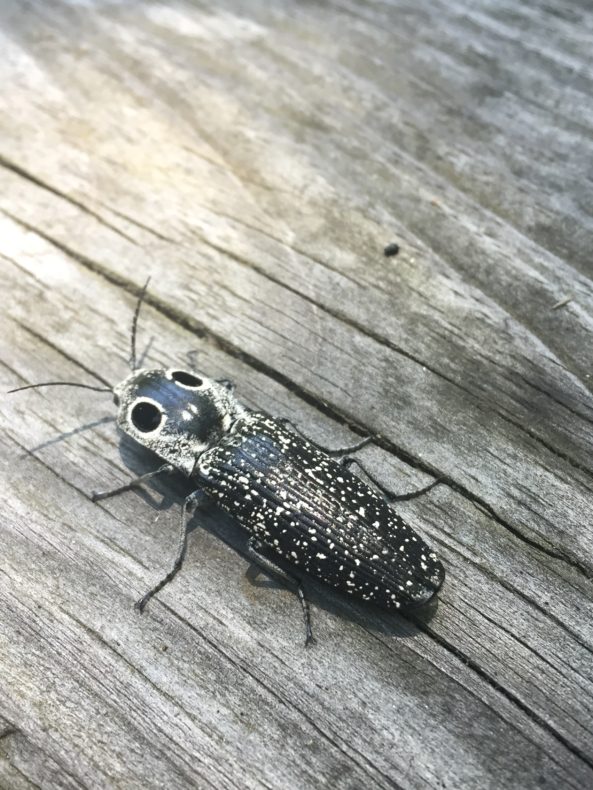
This huge bug hurled itself at me the other day and missed. It landed just to my left, on the wooden deck, and there it stayed—long enough for me to spend a little time admiring it.
Alaus oculatus is what it was, and likely still is these few days later, named for its false “eyes.” I’m a great fan of deception in nature. Here is evidence of Evolution saying “Predator, you might want to rethink your next move, because what you think you know may not jive with reality,” and this bug being all like “You can’t even handle this attitude so back the hell off.”
(I wish Evolution would return my calls. I have lots of ideas.)
The bug is commonly called the eastern-eyed click beetle (its larvae are called wireworms, which sounds like something you get from a swimming hole in Borneo that finds its way into orifices and burns like the dickens). But I’m tempted, always, to call all the critters in the family Elateridae popcorn beetles: If under threat they explode into the air, as when the right amount of heat (about 355 F, if you are wondering) hits a corn kernel and blows it inside out.
The beetle doesn’t invert, of course—turning out its organs, I suppose, would defeat the purpose of escaping the predator. Still, it appears it does no planning beyond the “get me outta here” reflex. But after accelerating many body lengths into the sky at up to 380 times gravity, and doing multiple flips along the way, a bug can be forgiven for an imperfect landing, which may or may not be belly up. A supine beetle is a vulnerable beetle, so with another pop, it will attempt to right itself. (For more about the constraints on its grace, you can read this article.)
What makes the click that propels these insects skyward? The mechanism is an exoskeletal hinge. It essentially divides the beetle’s body into two parts and is strung with a longitudinal muscle. The mechanism “latches” (by way of a spine and groove) when the bug arches its body to store elastic energy and, as the energy is released, the latch lets go (click!) and the bug’s center of mass shoots upwards. Then come the somersaults: In one study a related click beetle did 6 of them, complete overkill for the distance it needed to travel. (Evolution is such a showoff.) And then there’s that haphazard landing, hopefully well out of reach of the confounded hunter, if not belly down.
In fact, is it even fair of me to suggest this bug hurled itself “at me,” as if it had any say in its heading? Probably not. Also, in all honesty, I think it was flying at the time of our meeting. But the click thing is more interesting, so I’ll stick with my original explanation.
Apparently, A. oculatus is very common insect in Virginia, with a truly impressive click (which I didn’t hear, further evidence of the flight theory) and a stunning catapult, but I don’t recall ever encountering the creature before. This one demanded my attention, because it was almost 2 inches long and practically hit me in the face.
Big-ass bugs. So cool. The perfect distraction from, well, all of it.
—
I took the photo.
This was Distractions 1, which means I’ll probably do a series of Distractions posts. Unless I get, well, pulled in another direction.
TWO INCHES LONG! Wow. The click beetles I grew up with were barely one cm. We used to like to flip them over and watch them try to right themselves. After a number of clicks, they would lie completely still for a while. We thought they had used up their energy but maybe they were just so over our shit that they “couldn’t even”
PS. If Evolution never returns your calls, you could share your ideas with us. I promise we won’t steal them or even try to make them in our dank basement labs. I swear.
Thanks, Dr. D! It was indeed an impressive specimen.
Cool beetle! Sooner or later (probably later) there will be an Alaus oculatus in my box of fishing flies…